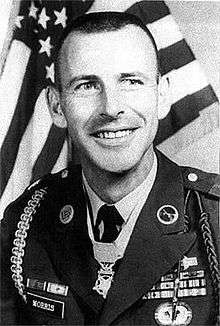Charles B. Morris
| Charles Bedford Morris | |
|---|---|
 Charles Morris | |
| Born |
December 29, 1931 Carroll County, Virginia |
| Died | August 22, 1996 (aged 64) |
| Place of burial | Morris Cemetery, Fancy Gap, Virginia |
| Allegiance | United States of America |
| Service/branch | United States Army |
| Years of service | 1953 - 1981 |
| Rank | Sergeant Major |
| Unit | 503rd Infantry Regiment, 173d Airborne Brigade (Separate) |
| Battles/wars | Vietnam War |
| Awards |
Medal of Honor Bronze Star Purple Heart |
Charles Bedford Morris (December 29, 1931 – August 22, 1996) was a United States Army soldier and a recipient of the United States military's highest decoration—the Medal of Honor—for his actions in the Vietnam War.
Biography
Morris joined the Army from Roanoke, Virginia in 1953,[1] and briefly served during the Korean War before serving in Vietnam. By June 29, 1966 he was a Sergeant in Company A, 2d Battalion (Airborne), 503rd Infantry Regiment, 173d Airborne Brigade (Separate). During a firefight on that day in the Republic of Vietnam, Morris continued to lead his squad, fight the enemy, and help the wounded despite being wounded himself four separate times. For his actions during the battle he was promoted to Staff Sergeant and, on December 14, 1967, awarded the Medal of Honor.
Morris reached the highest enlisted rank, Sergeant Major, before retiring from the Army. He died at age 64 and was buried in Morris Cemetery, Fancy Gap, Virginia.
Medal of Honor citation

Staff Sergeant Morris' Medal of Honor citation reads:
For conspicuous gallantry and intrepidity at the risk of his life above and beyond the call of duty. Seeing indications of the enemy's presence in the area, S/Sgt. Morris deployed his squad and continued forward alone to make a reconnaissance. He unknowingly crawled within 20 meters of an enemy machinegun, whereupon the gunner fired, wounding him in the chest. S/Sgt. Morris instantly returned the fire and killed the gunner. Continuing to crawl within a few feet of the gun, he hurled a grenade and killed the remainder of the enemy crew. Although in pain and bleeding profusely, S/Sgt. Morris continued his reconnaissance. Returning to the platoon area, he reported the results of his reconnaissance to the platoon leader. As he spoke, the platoon came under heavy fire. Refusing medical attention for himself, he deployed his men in better firing positions confronting the entrenched enemy to his front. Then for 8 hours the platoon engaged the numerically superior enemy force. Withdrawal was impossible without abandoning many wounded and dead. Finding the platoon medic dead, S/Sgt. Morris administered first aid to himself and was returning to treat the wounded members of his squad with the medic's first aid kit when he was again wounded. Knocked down and stunned, he regained consciousness and continued to treat the wounded, reposition his men, and inspire and encourage their efforts. Wounded again when an enemy grenade shattered his left hand, nonetheless he personally took up the fight and armed and threw several grenades which killed a number of enemy soldiers. Seeing that an enemy machinegun had maneuvered behind his platoon and was delivering the fire upon his men, S/Sgt. Morris and another man crawled toward the gun to knock it out. His comrade was killed and S/Sgt. Morris sustained another wound, but, firing his rifle with 1 hand, he silenced the enemy machinegun. Returning to the platoon, he courageously exposed himself to the devastating enemy fire to drag the wounded to a protected area, and with utter disregard for his personal safety and the pain he suffered, he continued to lead and direct the efforts of his men until relief arrived. Upon termination of the battle, important documents were found among the enemy dead revealing a planned ambush of a Republic of Vietnam battalion. Use of this information prevented the ambush and saved many lives. S/Sgt. Morris' gallantry was instrumental in the successful defeat of the enemy, saved many lives, and was in the highest traditions of the U.S. Army.
See also
References
 This article incorporates public domain material from websites or documents of the United States Army Center of Military History.
This article incorporates public domain material from websites or documents of the United States Army Center of Military History.
- "Charles B. Morris". Claim to Fame: Medal of Honor recipients. Find a Grave. Retrieved 2007-06-28.
- "Vietnam War Medal of Honor recipients (M-Z)". Medal of Honor citations. United States Army Center of Military History. October 3, 2003. Retrieved 2007-06-28.